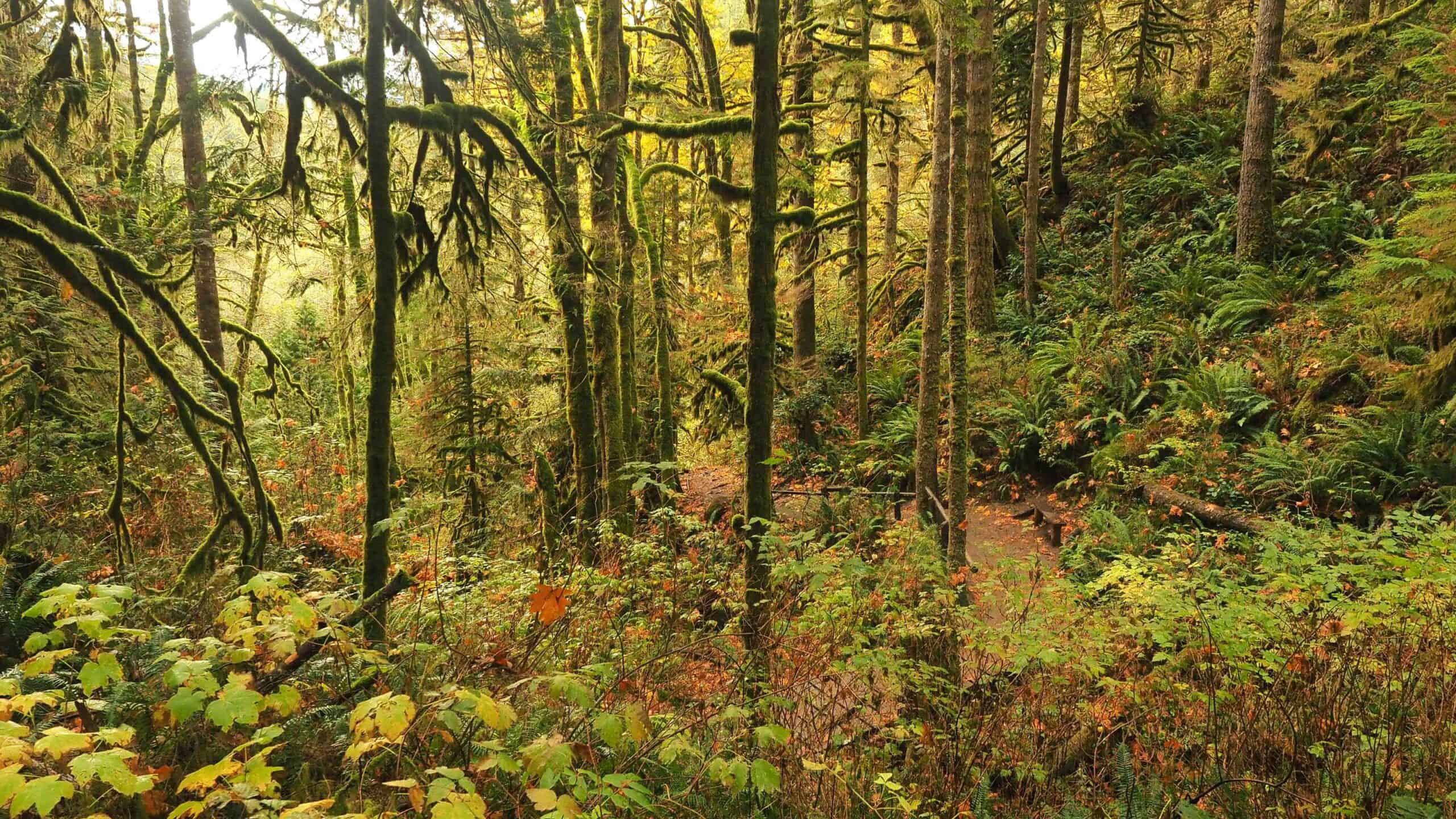Discover the rich tapestry of natural vegetation types in India, a diverse landscape that hosts a myriad of plant life. From the dense rainforests in the Western Ghats to the arid expanses of the Thar Desert, India’s flora reflects a fascinating blend of biodiversity.
As we embark on a journey to explore the natural vegetation types in India, we uncover the rich heritage and ecological significance of these varied landscapes.
Understanding the intricate interplay between climate, geography, and plant life offers a glimpse into the vibrant ecosystems that contribute to the nation’s environmental balance.
Join us in unravelling the secrets of India’s botanical wonders, where each region tells a unique story of survival, adaptation, and coexistence.
Natural Vegetation in India
India’s natural vegetation types spans a vivid spectrum, reflecting the country’s diverse topography and climatic zones. Tropical rainforests, draped along the western coast and the northeaster states, boast unparalleled biodiversity with towering trees forming a lush green canopy.
Moving towards the Himalayas, one encounters deciduous forests that shed leaves during dry seasons, adapting to the seasonal rhythm of precipitation. Semi-desert vegetation prevails in the arid expanses of states like Rajasthan, where hardy plants endure water scarcity and extreme temperatures.
The Deccan Plateau showcases dry deciduous forests, emphasizing resilience in arid conditions. Grasslands, both natural and cultivated, stretch across regions like Punjab and Haryana, supporting diverse flora and serving as vital grazing grounds for wildlife.
Mangrove forests along the coastal areas, notably in the Sundarbans, play a crucial role in protecting shorelines and providing habitats for unique species adapted to saline conditions.
Human impact, marked by deforestation and pollution, poses challenges to these ecosystems. However, concerted conservation efforts, guided by government policies and community participation, aim to safeguard India’s natural vegetation.
As the custodians of this rich heritage, understanding the importance and conservation of natural vegetation becomes imperative for ensuring a harmonious coexistence between nature and humanity.
Natural vegetation types in India can be divided into the following categories:
Tropical Evergreen Rainforests
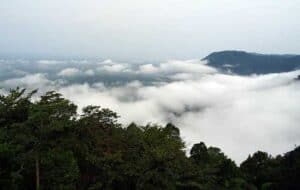
Tropical rainforests a type of natural vegetation in India are lush and dense ecosystems characterized by high temperatures and abundant rainfall throughout the year. Found in regions near the equator, these forests are home to an incredible diversity of plant and animal species.
The canopy of towering trees forms a green umbrella, creating a unique and vibrant habitat that plays a crucial role in maintaining the Earth’s biodiversity.
Features of Rainforests
Biodiversity: Tropical rainforests house an unparalleled variety of flora and fauna, including countless species yet to be discovered.
Canopy Structure: The presence of a dense canopy, formed by layers of interconnected trees, defines the intricate structure of rainforests.
Constant Precipitation: Rainforests receive consistent and abundant rainfall, creating a humid environment essential for the thriving of diverse life forms.
Rich Soil: Despite the heavy rainfall, the soil in rainforests tends to be nutrient-poor as the rapid decomposition of organic matter quickly absorbs available nutrients.
Importance of Rainforests
Tropical rainforests are vital for global ecological balance. They contribute significantly to:
Climate Regulation: Absorbing and storing large amounts of carbon dioxide, and releasing oxygen rainforests play a crucial role in regulating the Earth’s climate.
Biodiversity Conservation: Hosting a myriad of plant and animal species, rainforests are reservoirs of genetic diversity crucial for the survival of ecosystems.
Oxygen Production: Through photosynthesis, rainforests contribute substantially to the production of oxygen, vital for human and animal life.
Distribution of Rainforest in India
In India, tropical rainforests are primarily concentrated in the Western Ghats, the northeastern states, and the Andaman and Nicobar Islands. The Western Ghats, in particular, are renowned for their rich biodiversity and are home to several endemic species.
While smaller in scale compared to rainforests in other parts of the world, these regions in India are crucial for the conservation of unique ecosystems and endemic flora and fauna.
Trees and Animals Found in Tropical Rainforests
Trees
Mahogany (Swietenia): Known for its valuable timber, mahogany trees are tall and straight with dense foliage.
Rubber Tree (Hevea brasiliensis): The source of natural rubber, these trees have latex-producing capabilities.
Brazil Nut Tree (Bertholletia excelsa): Grows in the Amazon rainforest and produces large fruits containing edible seeds.
Plants:
Orchids: With diverse species, orchids thrive in the understory and on tree branches.
Bromeliads: These unique plants often grow on trees, collecting water in their rosette-shaped leaves.
Pitcher Plants (Nepenthes): Carnivorous plants that trap insects in fluid-filled pitchers.
Animals:
Jaguar (Panthera onca): A powerful big cat found in the dense rainforest, known for its elusive nature.
Toucan: Recognized for its colorful beak, the toucan is a vibrant bird species often seen in the canopy.
Poison Dart Frogs: Small, brightly colored frogs known for their toxicity, found in the understory.
These examples represent just a fraction of the immense biodiversity found in tropical rainforests, showcasing the complexity and interconnectedness of these ecosystems.
Deciduous Forests
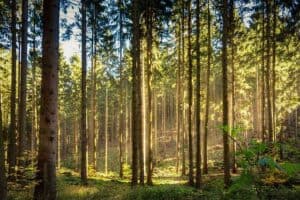
Deciduous forests are ecosystems characterized by trees that shed their leaves seasonally. These forests undergo a cyclical process of leaf shedding during a specific period, usually in autumn or dry seasons.
The transition from lush green to vibrant hues of red, orange, and yellow is a distinctive feature of these environments. Deciduous forests are found in temperate regions with moderate rainfall and are prevalent in North America, Europe, and parts of Asia.
Features of Deciduous Forests
Seasonal Leaf Shedding: Deciduous trees shed their leaves in a cyclical pattern, adapting to seasonal changes.
Moderate Climate: These forests experience four distinct seasons with moderate temperatures and precipitation.
Rich Biodiversity: Deciduous forests support a diverse range of plant and animal species due to their varied microhabitats.
Leaf Litter: Fallen leaves contribute to nutrient-rich leaf litter, fostering soil fertility.
Canopy Structure: The forest canopy is composed of a mix of broadleaf trees that create a layered structure.
Also Read: Different Types of Natural Vegetation
Importance of Deciduous Forests
Deciduous forests play a crucial role in the environment by:
Biodiversity Support: Providing habitat for diverse flora and fauna adapted to seasonal changes.
Oxygen Production: Contributing to the production of oxygen through photosynthesis.
Carbon Sequestration: Absorbing and storing carbon dioxide, aiding in climate regulation.
Soil Conservation: Preventing soil erosion with the help of the leaf litter covering the forest floor.
Distribution of Deciduous Forests in India
Deciduous forests are widespread in India, particularly in regions with a distinct dry season. They can be found in:
Central India: States like Madhya Pradesh and Chhattisgarh are known for their extensive deciduous forest cover.
Western Ghats: Parts of Maharashtra, Karnataka, and Goa host deciduous forests with rich biodiversity.
Eastern India: States like Odisha and Jharkhand also have significant deciduous forest areas.
Trees, Plants, and Animals in Deciduous Forests
Trees:
Teak (Tectona grandis): Valued for its hardwood, teak is a prominent deciduous tree in India.
Sal (Shorea robusta): Commonly found in central and eastern India, sal trees dominate deciduous forests.
Indian Rosewood (Dalbergia latifolia): Known for its dark and durable wood, this tree is native to deciduous regions.
Plants:
Bamboo: Abundant in deciduous forests, bamboo serves as a versatile and fast-growing plant.
Mahua (Madhuca longifolia): A deciduous tree producing edible flowers, seeds, and oil used in local communities.
Animals:
Indian Elephant: Deciduous forests provide essential habitat for these large herbivores.
Bengal Tiger: As an apex predator, the Bengal tiger relies on the diverse prey found in deciduous environments.
Indian Giant Squirrel: Arboreal and acrobatic, this squirrel species is adapted to life in the canopy of deciduous trees.
These examples highlight the varied and interconnected life forms that thrive in India’s deciduous forests, contributing to the overall biodiversity of these ecosystems.
Coniferous Forests
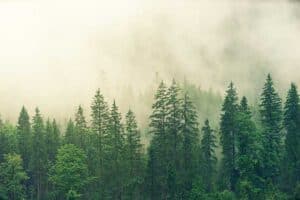
Coniferous forests, situated in the elevated altitudes of the Himalayan region, stand as resilient ecosystems adapted to cold climates. These forests are dominated by cone-bearing trees, which are well-suited to endure harsh weather conditions.
The unique adaptation of these trees allows them to thrive in environments characterized by low temperatures and snowfall. Coniferous forests contribute to the diverse ecological tapestry of the Himalayas, presenting a stark contrast to the deciduous forests found in lower altitudes.
Features of Coniferous Forests
Cone-Bearing Trees: Dominated by conifers like pine, fir, and spruce, these trees have needle-like leaves and produce cones.
Needle-Like Leaves: Trees have needle-shaped leaves that reduce water loss, aiding in survival in cold climates.
Evergreen Nature: Coniferous forests retain their greenery throughout the year, even in winter.
Snow Accumulation: The conical shape of trees helps shed snow, preventing excessive accumulation and damage.
Sparse Understory: Due to the acidic nature of the soil and the dense tree canopy, the understory vegetation is relatively sparse.
Importance of Coniferous Forests
Coniferous forests play a crucial role in the environment by:
Carbon Sequestration: Absorbing and storing carbon dioxide, contributing to climate regulation.
Habitat for Wildlife: Providing habitat for diverse wildlife adapted to cold climates, including rare and endangered species.
Wood Resources: Serving as a source of timber and wood products due to the valuable nature of coniferous wood.
Soil Protection: Preventing soil erosion with their dense network of roots and the protective layer of needles on the forest floor.
Distribution of Coniferous Forests in India
Coniferous forests in India are primarily concentrated in the Himalayan region, spanning states like Himachal Pradesh, Uttarakhand, and parts of Jammu and Kashmir, these forests thrive at higher altitudes where the climate is conducive to the growth of coniferous trees.
The unique ecological conditions of the Himalayas create an ideal environment for the development of these cold-adapted forests.
Trees, Plants, and Animals Found in Coniferous Forests
Trees:
Deodar (Cedrus deodara): A coniferous tree with fragrant wood, commonly found in the western Himalayas.
Blue Pine (Pinus wallichiana): Characterized by long needles, it thrives in higher altitudes of the Himalayan region.
Plants:
Rhododendrons: These hardy shrubs with vibrant flowers are adapted to the acidic soil of coniferous forests.
Animals:
Red Panda: An iconic species adapted to the cold climate, the red panda is found in the coniferous forests of the eastern Himalayas.
Himalayan Monal: A colorful bird endemic to the Himalayas, often spotted in coniferous habitats.
These examples showcase the specialized flora and fauna that have evolved to thrive in the unique conditions of India’s coniferous forests, contributing to the biodiversity of this distinctive ecosystem.
Dry Deciduous Forests

Dry deciduous forests represent a distinct ecosystem characterized by trees that shed their leaves during a specific dry period.
Unlike typical deciduous forests, where leaf shedding occurs in response to seasonal changes like winter, dry deciduous forests adapt to arid and dry conditions, shedding leaves during periods of water scarcity.
This unique characteristic helps the trees conserve water and endure prolonged dry spells, making them well-suited to regions with pronounced dry seasons.
Features of Dry Deciduous Forests
Leaf Shedding Adaptation: Trees in dry deciduous forests shed their leaves during dry periods to minimize water loss.
Thorny Understory: Many species in these forests have thorny shrubs in the understory, which deter herbivores and reduce water loss.
Adaptation to Arid Conditions: Trees are adapted to thrive in arid and semi-arid environments, with deep-rooted systems to tap into groundwater.
Seasonal Flowering: Some species exhibit seasonal flowering, maximizing reproductive efforts during more favorable conditions.
Varied Canopy Density: The canopy density varies, allowing some sunlight to reach the forest floor and support understory vegetation.
Importance of Dry Deciduous Forests
Dry deciduous forests contribute significantly to the ecosystem by:
Biodiversity Support: Providing habitat for a diverse range of flora and fauna adapted to arid conditions.
Water Conservation: Playing a role in water conservation by adapting to dry periods and helping regulate local water cycles.
Soil Conservation: Preventing soil erosion through the network of roots and leaf litter covering the forest floor.
Human Livelihoods: Supporting local communities through resources such as timber, non-timber forest products, and traditional practices.
Distribution of Dry Deciduous Forests in India
Dry deciduous forests are widespread in India, prominently found in:
Central India: States like Madhya Pradesh and Chhattisgarh feature extensive dry deciduous forest cover.
Deccan Plateau: Parts of Maharashtra, Karnataka, and Telangana host dry deciduous ecosystems.
Northern Plains: Some regions in the northern plains, including parts of Uttar Pradesh, also have dry deciduous forests.
Trees, Plants, and Animals Found in Dry Deciduous Forests
Trees:
Teak (Tectona grandis): A valuable hardwood tree commonly found in dry deciduous forests.
Sal (Shorea robusta): Widely distributed, sal trees dominate the flora in these regions.
Plants:
Lantana: An invasive shrub often found in the understory, affecting the composition of native vegetation.
Animals:
Indian Bison (Gaur): The largest extant bovine, adapted to the varied landscapes of dry deciduous forests.
Chital (Spotted Deer): A common herbivore species with a spotted coat, found in these ecosystems.
Dry deciduous forests exhibit a unique adaptation to water scarcity, fostering a range of flora and fauna that contribute to the ecological balance of diverse landscapes across India.
Thorn Forests and Scrublands
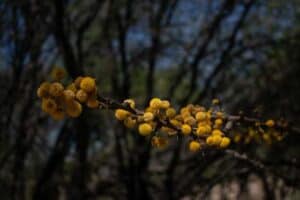
Thorn forests and scrublands are prevalent in arid and semi-arid regions, notably in states like Rajasthan and Gujarat. Thriving in areas with limited rainfall, these ecosystems showcase vegetation dominated by thorny shrubs and small trees.
The adaptability of these plants to arid conditions is reflected in their ability to conserve water and withstand the challenges posed by low precipitation, making them well-suited to the harsh environments of these regions.
Features of Thorn Forests and Scrublands
Thorny Shrubs: Dominated by plants with thorns, which serve as adaptations to deter herbivores and reduce water loss.
Drought-Resistant Flora: The vegetation is specially adapted to conserve water, with many species having deep roots to access groundwater.
Low Canopy: The overall height of vegetation is relatively low, allowing for efficient use of available water resources.
Sparse Understory: The understory is often sparse, with limited ground cover due to the arid conditions.
Adaptation to Extreme Temperatures: Plants in these regions often have adaptations to withstand high temperatures prevalent in arid environments.
Importance of Thorn Forests and Scrublands
Thorn forests and scrublands contribute significantly to the ecosystem and local communities by:
Biodiversity Support: Providing habitat for specially adapted flora and fauna, including unique plant and animal species.
Soil Conservation: Preventing soil erosion through the root systems of thorny plants and shrubs.
Traditional Uses: Serving as a source of resources for local communities, with certain plant species having cultural and economic importance.
Wildlife Habitat: Supporting a variety of wildlife adapted to arid conditions, such as desert foxes, rodents, and reptiles.
Distribution of Thorn Forests and Scrublands in India
In India, thorn forests and scrublands are widespread, primarily found in:
Rajasthan: Large expanses of arid and semi-arid regions in Rajasthan host extensive thorn forests and scrublands.
Gujarat: Parts of Gujarat, especially in the Kutch region, feature these ecosystems due to the prevailing arid climate.
Trees, Plants, and Animals Found in Thorn Forests and Scrublands
Trees and Plants:
Acacia Species: Thorny trees like Acacia contribute to the dominant vegetation in these regions.
Cacti: Well-adapted to arid conditions, various cactus species are found in scrublands.
Animals:
Indian Gazelle (Chinkara): These agile herbivores are adapted to the arid landscape and are commonly found in these regions.
Indian Bustard: A bird species adapted to open landscapes, including arid and semi-arid regions.
These examples illustrate the unique adaptations of flora and fauna in thorn forests and scrublands, highlighting their significance in sustaining life in challenging arid environments.
Mangrove Forests

Mangrove forests, characterized by coastal vegetation, thrive in areas influenced by tidal movements, notably exemplified by the Sundarbans in West Bengal.
These unique ecosystems are well-adapted to the challenging conditions of saline environments, where the influence of tides plays a pivotal role in shaping their distinctive features.
The Sundarbans, a notable example of mangrove forests, showcases the incredible ability of these ecosystems to flourish in the interplay between land and sea.
Features of Mangrove Forests
Salt-Tolerant Trees: Mangrove forests feature trees adapted to saline conditions, with specialized mechanisms to filter out excess salt.
Stilted Roots: Many mangrove species have stilted roots that provide stability in the muddy, tidal substrates.
Tidal Influence: These ecosystems are marked by the regular rise and fall of tides, influencing the distribution of water and nutrients.
Mudflats and Estuaries: Mangrove areas often include mudflats and estuaries, creating dynamic landscapes that support diverse flora and fauna.
Biodiversity Hotspots: Mangrove forests are rich in biodiversity, serving as nurseries for fish and providing habitats for numerous species.
Importance of Mangrove Forests
Mangrove forests hold immense ecological importance by:
Coastal Protection: Acting as a natural barrier, mangroves protect coastlines from erosion and storm surges.
Biodiversity Support: Providing critical habitats for fish, crustaceans, and migratory birds, contributing to overall marine biodiversity.
Carbon Sequestration: Mangroves absorb and store carbon dioxide, helping mitigate the impacts of climate change.
Livelihoods: Supporting local communities by offering resources such as timber, fish, and traditional medicines.
Distribution of Mangrove Forests in India
Mangrove forests in India are primarily concentrated in coastal regions, with notable areas including:
Sundarbans (West Bengal): The largest mangrove forest in the world, Sundarbans is a UNESCO World Heritage Site.
Bhitarkanika (Odisha): A significant mangrove area supporting diverse wildlife and ecosystems.
Gulf of Kutch (Gujarat): Home to extensive mangrove cover, contributing to the ecological diversity of the region.
Trees, Plants, and Animals Found in Mangrove Forests
Trees and Plants:
Rhizophora Species: Known for their stilted roots, Rhizophora species are common in mangrove forests.
Avicennia Species: These salt-tolerant trees are adapted to thrive in brackish water conditions.
Animals:
Sundarbans Tiger: An iconic subspecies of the Bengal tiger, adapted to the mangrove habitat.
Mudskippers: Fish adapted to amphibious life, often found in the intertidal zones of mangrove areas.
Mangrove forests encapsulate a delicate balance between land and sea, fostering unique ecosystems that are critical for coastal resilience and biodiversity.
Mountain Vegetation
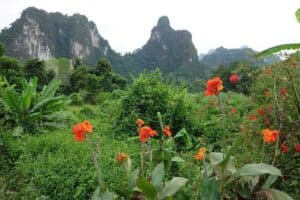
Mountain vegetation, found in the Himalayan region, showcases a diverse array of plant life that varies significantly with altitude.
As one ascends the slopes of the mighty Himalayas, distinct vegetation zones emerge, creating a remarkable transition from subtropical forests to alpine meadows.
This variation in mountain vegetation not only reflects the harsh climatic conditions at higher altitudes but also contributes to the unique biodiversity and ecological significance of the region.
Features of Mountain Vegetation
Altitudinal Zones: Mountain vegetation exhibits distinct zones such as tropical forests, temperate forests, subalpine, and alpine meadows at different altitudes.
Adaptation to Climate: Flora in each zone is adapted to specific temperature, precipitation, and soil conditions prevailing at different elevations.
Vegetation Belts: These ecosystems are characterized by vegetation belts, each featuring a specific mix of plant species adapted to its particular altitude.
Alpine Flora: At higher elevations, alpine vegetation prevails, comprising hardy plants capable of withstanding extreme cold and thin air.
Endemic Species: Many mountainous areas harbor endemic plant species uniquely adapted to the local environment.
Importance of Mountain Vegetation
Mountain vegetation holds crucial importance by:
Biodiversity Conservation: Serving as habitats for diverse flora and fauna, including rare and endemic species.
Water Regulation: Playing a vital role in regulating water flow, preventing soil erosion, and maintaining water quality.
Climate Stabilization: Contributing to climate stability by sequestering carbon and influencing local weather patterns.
Cultural Significance: Holding cultural and religious significance for communities residing in mountainous regions.
Distribution of Mountain Vegetation in India
Mountain vegetation in India is primarily concentrated in the Himalayan region, spanning across states like:
Himachal Pradesh: Featuring a range of vegetation zones from subtropical to alpine.
Uttarakhand: Encompassing diverse ecosystems, including the Nanda Devi Biosphere Reserve.
Arunachal Pradesh: Hosting a variety of mountain vegetation due to its diverse topography.
Trees, Plants, and Animals Found in Mountain Vegetation
Trees and Plants:
Rhododendron: Found in temperate and alpine zones, these vibrant flowers are a hallmark of mountainous regions.
Deodar (Cedrus deodara): A coniferous tree found in the Himalayan region, often in higher altitudes.
Animals:
Snow Leopard: An elusive predator adapted to the harsh conditions of alpine and subalpine ecosystems.
Himalayan Tahr: A herbivorous mammal well-adapted to rocky mountainous terrain, found in the higher reaches.
Mountain vegetation, shaped by altitude and climatic conditions, showcases the resilience of life in challenging terrains and contributes significantly to the overall biodiversity and ecological balance of the Himalayan region.
Desert Vegetation
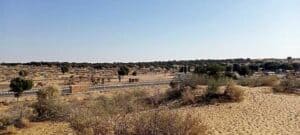
Desert vegetation, prevalent in the arid regions of northwest India, particularly in the Thar Desert, consists of resilient plants adapted to endure extreme desert conditions.
These hardy, drought-resistant plants have evolved unique strategies to thrive in the harsh desert environment, where water is scarce, temperatures are high, and the soil is often arid.
Features of Desert Vegetation
Xerophytic Adaptations: Plants in desert regions exhibit xerophytic features, such as reduced leaves or spines, to minimize water loss.
Deep Root Systems: Many desert plants have deep-reaching roots to tap into underground water sources.
Succulent Plants: Some species store water in their fleshy tissues, acting as reservoirs during dry periods.
Thorny Shrubs: Many desert plants have thorns, acting as protective features against herbivores and reducing water loss through transpiration.
Seasonal Flowering: Some desert plants bloom briefly after rainfall, capitalizing on moisture availability.
Importance of Desert Vegetation
Desert vegetation holds significance by:
Biodiversity Support: Providing habitats for unique and specially adapted plant and animal species.
Soil Stabilization: Preventing soil erosion through the establishment of root systems.
Human Livelihoods: Supporting traditional practices and livelihoods of local communities through uses like grazing and herbal medicine.
Ecosystem Resilience: Demonstrating the ability of life to adapt and thrive in extreme conditions, contributing to overall ecosystem resilience.
Distribution of Desert Vegetation in India
Desert vegetation in India is mainly concentrated in the Thar Desert, spanning regions of:
Rajasthan: The largest state in northwest India, hosting the vast expanse of the Thar Desert.
Gujarat: Parts of western Gujarat also exhibit arid conditions with unique desert flora.
Trees, Plants, and Animals Found in Desert Vegetation
Trees and Plants:
Khejri (Prosopis cineraria): A drought-resistant tree with deep roots, commonly found in the Thar Desert.
Cactus Species: Various cactus species, with succulent stems and modified leaves for water storage.
Animals:
Indian Gazelle (Chinkara): A swift herbivore adapted to arid landscapes, often found in the Thar Desert.
Desert Fox: Well-camouflaged and nocturnal, the desert fox is a carnivore adapted to the harsh desert conditions.
The desert vegetation of northwest India showcases the incredible ability of life to adapt and thrive in environments that pose extreme challenges.
These ecosystems, though seemingly barren, contribute significantly to biodiversity and play a crucial role in supporting life in the arid landscapes of the Thar Desert.
Semi-Desert Vegetation
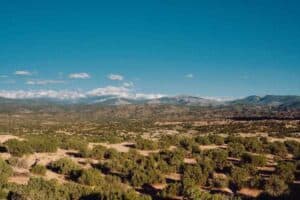
Semi-desert vegetation characterizes regions that lie on the cusp between deserts and more verdant landscapes. These areas experience arid conditions but possess a delicate balance that allows for the presence of a unique array of plants and animals adapted to semi-arid environments.
Semi-desert vegetation showcases nature’s resilience in the face of challenging climatic conditions, where life manages to persist despite limited water availability.
Features of Semi-Desert Vegetation
Drought-Adapted Flora: Plants in semi-desert regions are adapted to withstand prolonged periods of drought, often with water-storing capabilities.
Xerophytic Adaptations: Many species exhibit xerophytic features, such as reduced leaves or succulent tissues, to minimize water loss.
Sparse Canopy: The vegetation in semi-desert areas often features a sparse canopy, allowing sunlight to reach the ground.
Diversity of Plant Forms: Semi-desert vegetation includes a variety of plant forms, from low-lying shrubs to tall grasses adapted to arid conditions.
Seasonal Blooms: Some species showcase seasonal blooms, capitalizing on the intermittent availability of water.
Importance of Semi-Desert Vegetation
Semi-desert vegetation holds ecological importance by:
Biodiversity Support: Providing habitat for unique flora and fauna adapted to the challenges of semi-arid environments.
Soil Conservation: Contributing to soil stability through the root systems of drought-resistant plants.
Water Resource Management: Playing a role in water retention and absorption, aiding in the regulation of water flow in semi-arid regions.
Cultural Significance: Often holding cultural importance for local communities, with certain plants having traditional uses.
Distribution of Semi-Desert Vegetation in India
In India, semi-desert vegetation is notably found in regions such as:
Rajasthan: Large expanses of semi-desert landscapes are present in the western part of Rajasthan.
Gujarat: Parts of western Gujarat also exhibit semi-desert characteristics due to arid climatic conditions.
Haryana and Punjab: Some areas in these states feature semi-desert vegetation, particularly in rain-shadow regions.
Trees, Plants, and Animals Found in Semi-Desert Vegetation
Trees and Plants:
Khejri (Prosopis cineraria): A drought-resistant tree commonly found in semi-desert regions.
Babul (Acacia nilotica): Known for its thorny branches, this tree thrives in arid and semi-arid environments.
Plants:
Ziziphus Species: Shrubs like Ziziphus mauritiana, known as Ber, are well-adapted to semi-desert conditions.
Animals:
Indian Gazelle (Chinkara): A swift herbivore adapted to the arid landscapes, often found in semi-desert regions.
Desert Monitor Lizard: Well-adapted to dry conditions, this lizard species thrives in semi-desert habitats.
Semi-desert vegetation, with its unique adaptations and ecological functions, showcases nature’s ability to sustain life even in environments where water is a limiting factor.
The delicate balance of flora and fauna in these regions contributes to the overall biodiversity and ecological resilience of semi-arid landscapes in India.
Grasslands

Grasslands in India encompass both natural expanses and man-made fields distributed throughout the country. These areas feature a diverse array of grass species and serve as vital habitats for wildlife, particularly for grazing animals.
The open landscape of grasslands, whether native or cultivated, supports a dynamic ecosystem where the interplay between vegetation and herbivores shapes the biodiversity of these regions.
Features of Grasslands
Diverse Grass Species: Grasslands host a variety of grasses, ranging from tall and coarse to short and fine, adapted to different climatic conditions.
Open Landscape: Characterized by expansive, open spaces, grasslands lack dense tree cover, allowing for unobstructed views and mobility.
Seasonal Changes: Grasslands experience distinct seasonal changes, with variations in vegetation influenced by factors such as rainfall and temperature.
Man-Made Grasslands: Created through agricultural practices, man-made grasslands contribute to fodder production and livestock grazing.
Wildflowers: Many grasslands are adorned with wildflowers that add color and diversity to the landscape.
Importance of Grasslands
Grasslands play a critical role in the ecosystem by:
Biodiversity Support: Providing habitat for a variety of plant and animal species, including insects, birds, and small mammals.
Livestock Grazing: Serving as valuable grazing grounds for domesticated animals, supporting traditional pastoral practices.
Carbon Sequestration: Acting as carbon sinks, grasslands contribute to mitigating climate change by storing carbon in the soil.
Water Regulation: Grasslands aid in water absorption, preventing soil erosion and regulating water flow in river basins.
Distribution of Grasslands in India
Grasslands in India are distributed across various regions, including:
Punjab and Haryana: The northwestern states are known for extensive agricultural grasslands.
Western Ghats: Some natural grasslands are found in the drier regions of the Western Ghats.
Deccan Plateau: Portions of the Deccan Plateau feature both natural and cultivated grasslands.
Trees, Plants, and Animals Found in Grasslands
Plants:
Elephant Grass (Miscanthus species): Common in grasslands, this tall grass is a favorite of herbivores.
Blue Grama Grass (Bouteloua gracilis): Found in natural grasslands, this short grass is drought-resistant.
Animals:
Indian Antelope (Blackbuck): Commonly found in grasslands, the blackbuck is known for its distinctive spiral horns.
Grassland Birds: Species like larks, sparrows, and quails are adapted to the open habitat of grasslands.
Grasslands, whether shaped by nature or human activity, represent dynamic ecosystems vital for supporting biodiversity, traditional livelihoods, and ecological balance in various parts of India.
Economic Importance of India’s Natural Vegetation
Natural vegetation types in India holds immense economic significance, contributing to various sectors that sustain livelihoods and foster economic growth.
Forests, rich in timber and non-timber products, serve as a valuable resource for industries such as construction, furniture, and paper manufacturing.
Additionally, medicinal plants derived from diverse ecosystems contribute to the pharmaceutical industry, offering natural remedies and driving economic activities.
Agriculture, a cornerstone of the Indian economy, relies heavily on the country’s natural vegetation. The fertile alluvial soils of river plains and the biodiversity in diverse ecosystems support crop cultivation, ensuring food security and income for millions of farmers.
Furthermore, the rich biodiversity of natural vegetation attracts tourism, a vital economic sector, drawing nature enthusiasts and adventure seekers to explore India’s varied landscapes.
Environmental Benefits of Natural Vegetation of India
India’s natural vegetation provides a myriad of environmental benefits crucial for ecological balance and sustainable living. Forests act as carbon sinks, mitigating climate change by sequestering carbon dioxide.
They also regulate water cycles, preventing soil erosion and ensuring a steady supply of freshwater. Wetlands and mangroves serve as natural buffers against storms and floods, protecting coastal areas.
The diverse flora supports a complex web of biodiversity, sustaining numerous plant and animal species. This biodiversity contributes to ecosystem resilience, enhancing the ability of natural systems to adapt to environmental changes.
Also, natural vegetation plays a pivotal role in maintaining air quality by absorbing pollutants and releasing oxygen, essential for human and animal life.
Preserving and restoring these ecosystems is not just a matter of environmental conservation but is integral to the overall well-being of the planet and its inhabitants.
Human Impact on Natural Vegetation of India
Human activities have exerted a substantial impact on the natural vegetation of India, altering landscapes and ecosystems. Deforestation, driven by urbanization, agriculture, and infrastructure development, has led to the loss of extensive forest cover.
The conversion of natural habitats into agricultural lands, coupled with indiscriminate logging, has disrupted the delicate balance of ecosystems. Additionally, industrialization has contributed to air and water pollution, affecting the health of vegetation.
Unregulated tourism and excessive grazing by livestock further intensify the pressure on natural vegetation, leading to habitat degradation and loss of biodiversity.
Recognizing the consequences of these human-induced impacts is crucial for implementing sustainable practices and conservation measures.
Conservation Efforts for Natural Vegetation in India
India has implemented various conservation efforts to safeguard its natural vegetation. Government policies and laws play a pivotal role in regulating and promoting conservation.
The Forest Conservation Act (1980) restricts diversion of forest lands for non-forest purposes, emphasizing the importance of preserving ecosystems.
The National Forest Policy (1988) focuses on sustainable forest management, afforestation, and biodiversity conservation.
Initiatives like the Green India Mission aim to increase forest and tree cover, promoting afforestation and ecological restoration.
National Parks and Wildlife Sanctuaries, established under the Wildlife Protection Act (1972), provide protected areas for diverse flora and fauna.
Government-led campaigns such as ‘Namami Gange’ focus on cleaning and restoring river ecosystems, indirectly benefiting riparian vegetation. Community-based conservation models, involving local communities in sustainable resource management, have gained traction.
These efforts collectively aim to mitigate human impact, promote biodiversity conservation, and ensure the sustainable coexistence of human activities and natural vegetation in India.
Conclusion
Exploring the rich tapestry of natural vegetation types in India unveils the diverse ecosystems that shape the subcontinent’s landscapes. From the dense rainforests to the resilient semi-desert vegetation, each type reflects the intricate dance between climate, geography, and life.
However, human impact looms large, demanding a delicate balance between progress and preservation. Conservation efforts, guided by policies and community involvement, emerge as vital guardians of India’s natural heritage.
This guide serves not just as an informational repository but as a call to action, urging us to appreciate, protect, and sustain the intricate web of life woven into India’s natural vegetation.
